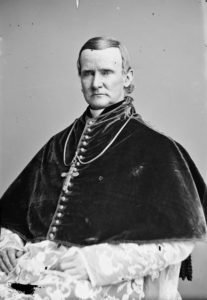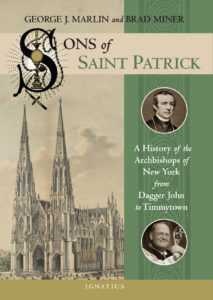Context: Throughout his remarkable career, John McCloskey – born in Brooklyn to Irish-immigrant parents – always expressed caution bordering on unwillingness to take each of the steps that eventually led Pope Pius IX to elevate him to the cardinalate in 1875. In this excerpt, McCloskey demonstrates that reticence leading up to his selection as New York’s second archbishop.
Archbishop John Hughes died on January 3, 1864. As the archbishop of New Orleans, Jean-Marie Odin, wrote a few months later: “No sooner had God called to his eternal reward the good and greatly lamented Dr. Hughes, than all eyes were turned towards Albany to find him a successor.” [McCloskey was then Bishop of Albany.] This Bishop McCloskey dreaded. He wrote to an old friend in Rome, Karl-August von Reisach, now Cardinal Reisach and a close advisor to Pope Pius IX, pleading that this cup might pass from him. The letter begins:
Your Eminence will pardon me, I trust, if, presuming on the kindness and condescension shown me in the past, I now venture to have recourse to you in a moment which for me is one of deepest anxiety and fear. Your Eminence, as a member of the Sacred Congregation de Propaganda Fide, will have learned, most probably before this reaches you, that among the names commended through the Sacred Congregation to the Holy See to fill the vacancy caused by the much lamented death of the illustrious Archbishop of New York, my name unfortunately is placed first on the list. Now I write to implore your Eminence in case there should be any danger of my appointment or of my being transferred from Albany to New York to aid me in preventing it, and to save me from the humiliation and misery of being placed in a position for the duties and responsibilities of which I feel myself, both physically and morally, wholly unfit and unequal.
Can he actually have believed this last part about himself ? Perhaps because of his “history” of supposed infirmity one might credit it as a convincing argument about physical unfitness. But what were this man’s moral deficits?
This letter should have gone to Cardinal Alessandro Barnabò, the head of Propaganda Fide. But, Bishop McCloskey said, he did not wish to be too forward in assuming that he was actually in the running to be New York’s second archbishop.

Now it might be argued that Bishop McCloskey was following some protocol, real or imagined, by which a man about to be elevated to great responsibility turns away the laurel, as Caesar three times refused the crown offered by Marc Antony. But the sentiments he expressed in the letter to Reisach seem all too real. He writes that he is sincere “when I say that I possess neither the learning, nor prudence, nor energy, nor firmness, nor bodily health and strength, which are requisite for such an arduous and highly responsible office.”
But in the end, he undercuts whatever seriousness there is in his plea to be passed over by admitting that, “once the decision is made and the Holy Father speaks, there remains for me nothing but silence. His will is in all things to me a law.” And on May 6, 1864 (fifty-four years to the day after McCloskey’s baptism by Father Benedict Fenwick at Old St. Patrick’s Cathedral), the pope made it official. On August 27, the reluctant McCloskey was installed as the second archbishop of New York. And for all his alleged lack of “energy,” “firmness,” or “bodily health and strength,” he would ably and vigorously serve the archdiocese for the next two decades.
When McCloskey learned that his fate had been sealed by the pope, he left for New York City that very evening on the night boat from Albany. He was accompanied on the journey by Father John Conroy, vicar-general of the Diocese of Albany. At the Hudson River dock in Manhattan, they were met by McCloskey’s secretary, Father Francis McNeirny, who had gone down to the city ahead of them.
The trio would be the first, second, and third men to serve as Albany’s spiritual leader. It was a gathering reminiscent of the day in 1826 at the Mount [St. Mary’s Seminary in Maryland] when Father John Dubois left to be consecrated as third bishop of New York, with [future first Archbishop of New York] John Hughes (on his way to his first parish assignment) accompanying him in the carriage, and the young student John McCloskey happily waving as he saw them off.
For Bishop McCloskey himself, the move back to New York [where he had begun his priestly career] at the height of the Civil War was unsettling. Even more disturbing was the appearance the very next morning at his residence at 218 Madison Avenue of a deranged woman who loudly proclaimed – to McCloskey himself – that she was the new archbishop’s mother. She wasn’t. It was the future cardinal who had answered the door, and when McCloskey introduced himself, the woman was undaunted and demanded to be given a bedroom in the house. The police were summoned, and she was led away. Later, at the police station, as McCloskey gave a formal statement about the episode, the guileless desk sergeant commented that the woman might be an impostor, but: “She tells a pretty straight story for a crazy woman.”
When the woman was brought up from her cell to face the formal charge against her, she pleaded with McCloskey: “Don’t leave me here with these rascals! They tried to ruin me” – clearly an allegation of sexual assault. McCloskey turned to the embarrassed desk sergeant and with the slightest smile said: “Yes, she tells a very straight story indeed.”
On March 15, 1875, Pius IX chose McCloskey to become the very first American cardinal, thus ending the United States status as “mission territory.”















